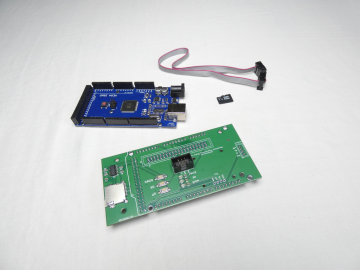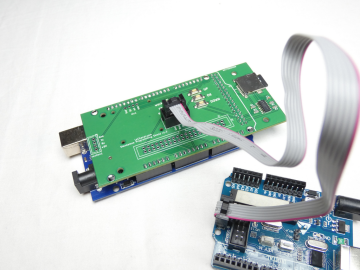Standalone Arduino Programmer
Overview
The standalone Arduino Programmer can program many atmel chip in stand alone mode which means it does not need a computer to operate. This is very useful for automating the programming of large number of chips.
This product is a shield for the Arduino Mega.
You will need to program the Arduino Mega only once with a computer then the programmer will be stand-alone and only need connection with a power source.
The principle is:
- Program the Arduino Mega with the sketch provided below.
- Flash the target sketch on a SD card
- Insert the SD card / Connect the mega to the power supply.
- Connect the shield to the target device with the 6 pin cable.
- Press OK on the shield.
- Target is now programmed.
Features
- Onboard Micro SD card.
- 3 operation LED (work / ok / error).
- 3 operation button.
- 6 pin SPI connection to target.
- Additional GPIO pins available for expansion.
- Provision for use of a small LCD screen.
Usage
Preparing the programmer
- Compile the target sketch on Arduino IDE.
- Locate the produced hex file.
- Copy it to the SD card.
- Rename the file as 'firmware.hex'.
- Insert the SD card in the programmer.
Production Usage
- Connect the 6 pin ribbon cable to the target device.
- Press the OK button.
- Sucessful flash will be indicated with the green led 'ok'
Firmware
Several firmwares that can be used on the programmer.
Atmega_Hex_Uploader_Fixed_Filename firmware
This is the basic firmware. It allows programming with the buttons and confirmation is indicated with leds.
Download the firmware from this github repo:.
https://github.com/nickgammon/arduino_sketches
Choose the sketch named Atmega_Hex_Uploader_Fixed_Filename
A special version of SDFat library is needed. Download it from here below. Do not use the latest version of this library or compilation will fail.
https://github.com/greiman/SdFat/releases/tag/1.1.4
- Install the above library.
- Open the Atmega_Hex_Uploader_Fixed_Filename sketch in the Arduino IDE.
- Select Tools -> Board: -> Arduino AVR Boards -> Arduino Mega or Mega 2560
- Connect the Mega to the usb port.
- Click on Upload to write the programming sketch.
Usage
Only the OK button is functional. Press OK to start flashing the target. A sucessful flash will be indicated by the green LED blinking. Errors will be reported using the patterns below
Problems with SD card or programming target chip
Red x 1 = Cannot open SD card Red x 2 = Cannot read file 'firmware.hex' Red x 3 = Cannot enter programming mode in target chip Red x 4 = This chip does not have a bootloader fuse Red x 5 = Cannot read chip signature Red x 6 = Unrecognised signature Red x 7 = Bad start address in hex file for code Red x 8 = Verification error
Problems with firmware.hex file
Red+yellow x 1 = Line in file is too long Red+yellow x 2 = Line in file is too short Red+yellow x 3 = Line does not start with a colon (:) Red+yellow x 4 = Invalid hex digits (should be 0-9, A-F) Red+yellow x 5 = Bad sumcheck at end of line Red+yellow x 6 = Line not expected length Red+yellow x 7 = Unknown record type Red+yellow x 8 = No 'end of file' record in file Red+yellow x 9 = File will not fit into flash of target
Credits to the author of this firmware who documented the usage here.



